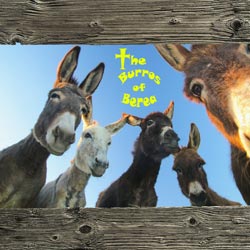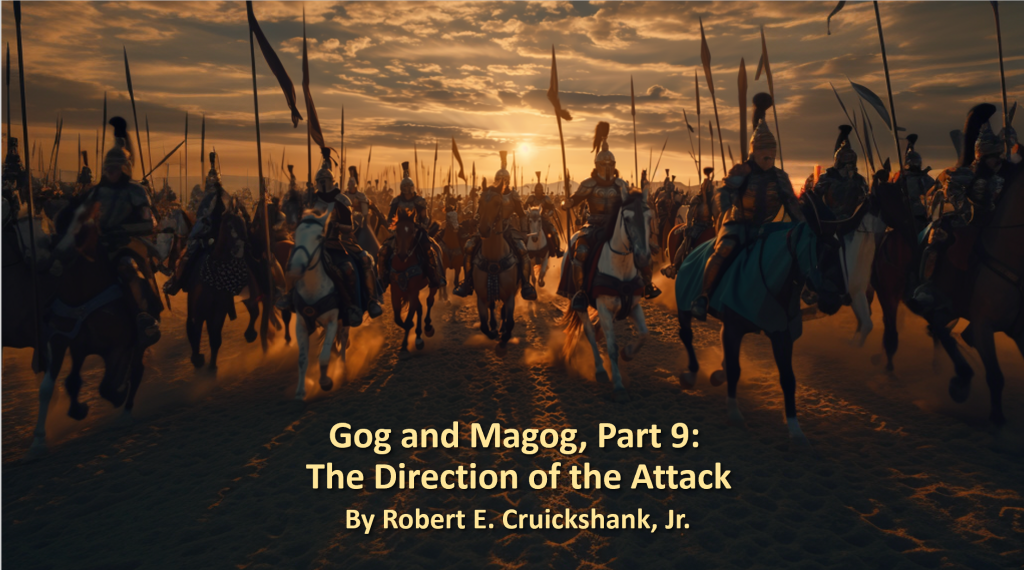Gog and Magog, Part 9: The Direction of the Attack
Copyright © Robert E. Cruickshank, Jr. (March 29, 2024)
All Rights Reserved
“Therefore prophesy, son of man, and say to Gog: This is what the Lord God says: ‘On that day when My people Israel are living securely, will you not know it? You will come from your place out of the remote parts of the north, you and many peoples with you, all of them riding horses, a large assembly and a mighty army; and you will come up against My people Israel like a cloud to cover the land. It shall come about in the last days that I will bring you against My land, so that the nations may know Me when I show Myself holy through you before their eyes, Gog” (Ezekiel 38:15-16).
In the previous installment, we noted that Gog turning his “hand against” the “ruins that are now inhabited” and “against the people who are gathered from the nations” (Ezek. 38:12), coincides perfectly with the description of Israel during the Restoration Period (Ezra 2:70; 3:1). What Ezekiel says next, regarding the direction of Gog’s attack, reinforces the importance of understanding this prophecy in its ancient context.
But the prophecy pundits don’t see it this way.
In Ezekiel 38:15, Gog comes out of his place in “the remote parts of the north.” Back in verses 5 and 6, Gog’s allies also come from “the north.” And in chapter 39 verse 2, it is reiterated that the attack comes from “the remote parts of the north.” For the purveyors of pop-prophecy, “the north” can mean only one thing – Russia! And even Ronald Reagan couldn’t resist getting in on the act:
“What other powerful nation is to the north of Israel? None. But it didn’t seem to make sense before the Russian revolution, when Russia was a Christian country. Now it does, now that Russia has become communistic and atheistic, now that Russia has set itself against God. Now it fits the description of Gog perfectly…. For the first time ever, everything is in place for the battle of Armageddon and the Second Coming of Christ. It can’t be too long now. Ezekiel says that fire and brimstone will be rained upon the enemies of God’s people. That must mean that they will be destroyed by nuclear weapons.”[1]
Fast forward to our own time, Ed Taylor informs us:
“As Russia descends from the North down into Israel, the destruction of the armies of Israel in the last day’s war will be so great that it will take over seven months to bury all of the dead and gather all the weapons and burn them. How does this relate to the current crisis in Ukraine? It’s a striking revelation of just how much of a formidable foe Russia currently is and will continue to be in the last days. God predicts it.”[2]
Bringing Evil from the North
Once again, the issues here are audience relevance and historical context. Neither of which have anything to do with nuclear threats in the 1970s or Russia invading Ukraine in 2022. When ancient Israelites heard terms like “the north” or “the remote parts of the north,” they would have thought of the direction from which their foes historically attacked.
For example, when prophesying about the Babylonian invasion, Jeremiah 4:6 says: “I am brining evil from the north, with great destruction” (cf. Jer. 1:13-15; 3:18; 6:1, 22; 10:22, Zech. 2:6-7). But Babylon was to the east of Jerusalem, not the north. How could an invasion from the east have been described as God “bringing evil from the north?”
As most commentators recognize, “the north” doesn’t typically refer to the origin of Israel’s attackers but to the trajectory of their attack. Logistically, it made sense for Nebuchadnezzar to avoid routing his armies through a vast desert. Instead, they went up and around it and then descended upon Jerusalem from the north. Consequently, it would have been even more so the case for Haman and his forces coming from Persia – which was even farther east than Babylon.
As archaeologist Barry Beitzel puts it: “The Bible’s use of the expression ‘north’ denotes the direction from which a foe would normally attack and not the location of its homeland.”[3]
The Valley of Hamon-Gog
As with the previous observations, all the textual indictors continue to point to Haman the Agagite as Gog of the Land of Magog. And finally, Gog’s burial site makes the connection unmistakable. Ezekiel 39:11 says:
“On that day I will give Gog a burial place there in Israel, the valley of those who pass by east of the sea, and it will block the way of those who would pass by. So they will bury Gog there with all his horde, and they will call it the Valley of Hamon-Gog” (Ezekiel 39:11).
On this passage, Gary DeMar writes: “According to Ezekiel 39:11 and 15, the place where the army of Gog is buried will be known as the Valley of Hamon-Gog. The word hamon in Ezekiel is spelled in Hebrew almost exactly like the name Haman. In Hebrew, both words have the same ‘triliteral root’ (hmn). Only the vowels are different.[4]
Notice what DeMar says: “Only the vowels are different.” This is more significant than we realize. Why? Because vowels weren’t added to the Hebrew language until sometime between 700 and 1000 AD.[5] Ezekiel is writing 1600 years before vowels even existed in the Hebrew language. This means that, when an ancient Jew read the books of Ezekiel and Esther, “Haman” and “Hamon” would have been the exact same word. The correspondence to Haman is consistent from the time Gog appears in Ezekiel’s text all the way through to Gog’s bitter end.
A Quick Recap
To review what’s been covered so far in this series: the direction of the attack (the north), the goal of the attack (gold and silver, cattle and horses), the Jews’ situation at the time of the attack (dwelling securely in unwalled villages), the time of the attack itself (the latter days from Ezekiel’s perspective), the nations involved in the attack (all Persian), the weapons used in the attack (ancient and not modern), the identification of the attacker himself (the chief prince of those Persian nations), and the fact that the attacker was spoken of in the past (an Amalekite) all point to attack of Haman, in the book of Esther, as the one identified as Gog of the Land of Magog, in the book of Ezekiel.
In our next installment, we’ll look at John’s reuse of the Gog and Magog motif, in the book of Revelation, and see why the situation at the time of Esther was the perfect mirror-image for the situation at the time of John’s writing.
_____________________________________________________________
[1] From an address that Ronald Reagan gave at a dinner with California legislators in 1971. A shorter version of this address is found in Paul Boyer, When Time Shall Be No More: Prophecy Belief in Modern Culture (Cambridge, MA: The Belknap Press of Harvard University, 1992), 162.
[2] http://edtaylor.org/2022/03/04/ukraine-russia-and-bible-prophecy-ezekiel-38-39/
[3]The Moody Atlas of Bible Lands (Chicago, IL: Moody Press, 1985), 5.
[4] The Gog and Magog End-Time Alliance: Israel, Russia, and Syria in Bible Prophecy (Powder Springs, GA: American Vision Press. 2016), p. 59.
[5] Bodie Hodge, Tower of Babel: The Culture History of Our Ancestors (Green Forest, AR: Master Books, 2013), p. 114, fn.




